Summary
High dose narcotic anesthesia with fentanyl or morphine is not associated with significant direct myocardial depression. Morphine is reported to produce arteriolar dilatation and a decrease in SVR (probably due to histamine release) while fentanyl is not. Studies were undertaken to determine if morphine or fentanyl caused histamine release; if such a release correlated with hemodynamic changes, and if H1 and H2 antagonists could provide protection. In a randomized double blind study of 40 patients in 4 groups, patients who received morphine (1 mg/kg) demonstrated significant increases in plasma histamine (880±163 to 7,437±2,684 pg/ml−p<0.01) accompanied by an increase in CI (2.4±0.2 to 3.0±0.2 l/min/m2−p<0.01) and decreases in\(\overline {BP} \) (88±4 to 61±4 torr−p<0.01) and SVR (15.5±1 to 9.0±1 torr-l-min−1 p<0.01). The prior administration of H1 (dyphenhydramine 1 mg/kg) and H2 (cimetidine 4 mg/kg) antagonists provided significant protection (SVR 17.4±1 to 14.6±1 torr-l-min−1−p<0.05) although histamine increased comparably (1,059±22 to 7,653±4,242 pg/ml−p<0.05). In a separate study, seven patients receiving fentanyl 50 µg/kg showed no histamine changes (935±51 to 685±51 pg/ml) and no significant hemodynamic response. Eight patients receiving morphine 1 mg/kg again showed significant increases in plasma histamine (880±163 to 7,480±2,230 pg/ml−p<0.05) which collelated with the decrease in SVR (r=0.81). These data demonstrate that morphine releases histamine in amounts which correlate with the hemodynamic changes seen. Prior administration of H1 and H2 histamine antagonists provide significant protection — more so than either alone. Fentanyl produced no histamine release which may account for much of the cardiovascular stability reported with this drug.
Zusammenfassung
Hochdosierte Anästhesie mit Fentanyl oder Morphium ist nicht mit einer bedeutsamen direkten Myokard-Depression assoziiert. Morphine werden in der Literatur als arteriell dilatierend und SVR (systemic vascular resistance) vermindernd beschrieben. Es werden, wahrscheinlich aufgrund von Histaminfreisetzung, dies ist für Fentanyl nicht der Fall, Studien durchgeführt um festzustellen, ob Morphium oder Fentanyl zu Histaminfreisetzung führt, ob eine solche Freisetzung mit hämodynamischen Veränderungen einhergeht und ob H1- und H2-Antagonisten dagegen schützen können. Bei einer randomisierten Doppelblindstudie von 40 Patienten (4 Gruppen) zeigten die Patienten, die nur Morphium (1 mg/kg) erhielten, einen signifikanten Anstieg in der Plasmahistaminkonzentration (880±163 zu 7 437±2 684 pg/ml−p<0.01) zusammen mit einem Anstieg des CI (cardiac index) (2.4±0.2 zu 3.0±0.2 l/min/m2−p<0.01), einen mittleren arteriellen Blutdruckabfall (88±4 zu 61±4 Torr−p<0.01) und SVR-Abfall (15.5±1 zu 9.0±1 Torr-l-min-−1,p<0.01). Die Gabe von H1-(Dyphenhydramin 1 mg/kg) und H2-(Cimetidin 4 mg/kg) Antagonisten vor der Morphiumgabe führte zu einer signifikanten Protektion (SVR 17.4±1 zu 14.6±1 Torr-l-min−1−p<0.05), obwohl der Histamingehalt vergleichsweise anstieg (1 059±22 zu 7 653±4 242 pg/ml−p<0.05). In einer anderen Studie zeigten 7 Patienten, die Fentanyl (50 µg/kg) erhielten, keine Änderung im Histaminspiegel (935±51 zu 685±51 pg/ml) und keine signifikanten hämodynamischen Reaktionen. 8 Patienten, die Morphium (1 mg/kg) erhielten, zeigten wiederum einen signifikanten Anstieg im Plasmahistaminspiegel (880±163 zu 7 480±2 230 pg/ml−p<0.05), welcher mit einem Abfall in SVR korrelierte (r=0.81).
Diese Daten zeigten, daß Morphium Histamin in solchen Mengen freisetzt, die mit den beobachteten hämodynamischen Veränderungen korrelieren. Vorherige Gabe von H1- und H2-Histaminantagonisten stellen einen signifikanten Schutz dar — mehr als eines von beiden alleine gegeben. Fentanyl führt zu keiner Histaminfreisetzung, welches der in der Literatur geschilderten kardiovaskulären Stabilität dieses Arzneimittels Rechnung trägt.
Similar content being viewed by others
References
Brimblecoombe RW, Duncan WAM, Durant GJ et al. (1975) Cimetidine — a non-thiouren H2-receptor antagonist. J Int Med Res 3:86–92
Dale HH, Laidlaw PP (1911) Further observation on the action of β-imidozololethylamine. J Physiol (London) 43:182–195
Durant GJ, Ganellin CR, Parsons ME (1975) Chemical differentiation of histamine H1 and H2 receptor antagonists. J Med Chem 18:905–909
Ginsburg R, Bristow MR, Stinson EB (1980) Histamine receptors in the human heart. Life Sciences 26:2245–2249
Lorenz W, Doenicke A, Schöning B et al. (1980) H1+H2-receptor antagonists for premedication in anesthesia and surgery: A critical view basing on randomized clinical trials with Haemaccel and various antiallergic drugs. Agents and Actions 10:114–124
Lowenstein E, Hallowell P, Levine FH (1969) Cardiovascular responses to large doses of intravenous morphine in man. New Engl J Med 281:1389–1393
Lowenstein E, Whiting RB, Bittar DA (1972) Local and neurally mediated effects of morphine on skeletal muscle vascular response. J Pharm Exp Ther 180:359–367
Moss J, Fahmy NR, Sunder N, Beaven MA (1981) Hormonal and hemodynamic profile of an anaphylactic reaction in man. Circulation 63:210–213
Moss J, Rosow CE, Savarese JJ, Philbin DM, Kniffen KJ (1981) Role of histamine in the hypotensive action of d-tubocurarine in humans. Anesthesiology 55:19–25
Philbin DM, Moss J, Akins CW, Rosow CE, Kono K, Schneider RC, VerLee TR, Savarese JJ (1981) The use of H1 and H2 histamine antagonists with morphine anesthesia: A double blind study. Anesthesiology 55:292–296
Powell JR, Brody MJ (1976) Identification and specific blockade of two receptors for histamine in the cardiovascular system. J Pharmacol Ex Ther 196:1–14
Rosow CE, Moss J, Philbin DM, Savarese JJ (1982) Histamine release during morphine and fentanyl anesthesia. Anesthesiology 56:93–96
Schmidt CF, Livingston AE (1933) The action of morphine on the mammalian circulation. J Pharm Exp Ther 47:411–441
Stanley TH, Webster LE (1978) Anesthetic requirements and cardiovascular effects of fentanyl oxygen and fentanyl diazepam oxygen anesthesia in man. Anesth Analg 57:411–416
Verma SC, McNeill JH (1977) Cardiac histamine receptors: Differences between right and left atria and right ventricle. J Pharmacol Exp Ther 200:352–362
Author information
Authors and Affiliations
Rights and permissions
About this article
Cite this article
Philbin, D.M., Moss, J., Rosow, C.E. et al. Histamine release with intravenous narcotics: Protective effects of H1 and H2-receptor antagonists. Klin Wochenschr 60, 1056–1059 (1982). https://doi.org/10.1007/BF01716971
Issue Date:
DOI: https://doi.org/10.1007/BF01716971




